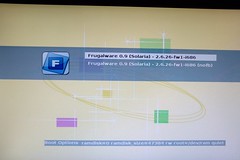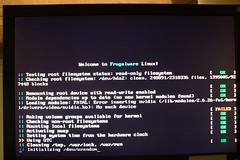 Slax is a LiveCD system, based on Slackware. When I booted it with default option, there is a driver issue because of wrong driver version. But, the VESA mode is ok to use, just the resolution is too small for these days.
Slax is a LiveCD system, based on Slackware. When I booted it with default option, there is a driver issue because of wrong driver version. But, the VESA mode is ok to use, just the resolution is too small for these days.Boot-time for my hardware took about a minute. The desktop environment is KDE 3.5 and Kernel is 2.6.27.8. I checked the website, its build system is very convenient to compose your own of packages, but adding dependencies needs some clicks. I added NVIDIA 96xx driver, Firefox, pppoe-kemo, and removed KOffice. The final is about 198 MB and only took 4 minutes or less to download, the download speed is very fast. I used external USB harddrive this time, because I want it can be able to store data/session.
I unpacked tarball to disk and ran ROOT/boot/liloinst.sh instead of bootinst.sh (for FAT-only) because the partition is ext3. It provided a clear message about what would be done:
-=-=-=-=-=-=-=-=-=-=-=-=-=-=-=-=-=-=-=-=-=-=-=-=-=-=-=-=-=-=-=-=-=-=-=-=-=-=-=-
Welcome to Slax boot installer
-=-=-=-=-=-=-=-=-=-=-=-=-=-=-=-=-=-=-=-=-=-=-=-=-=-=-=-=-=-=-=-=-=-=-=-=-=-=-=-
This installer will setup disk /dev/sdb to boot only Slax from /dev/sdb1.
Warning! Master boot record (MBR) of /dev/sdb will be overwritten.
If you use /dev/sdb to boot any existing operating system, it will not work
anymore. Only Slax will boot from this device. Be careful!
Press any key to continue, or Ctrl+C to abort...
Flushing filesystem buffers, this may take a while...
Updating MBR to setup boot record...
Warning: /dev/sdb is not on the first disk
Warning: The initial RAM disk is too big to fit between the kernel and
the 15M-16M memory hole. It will be loaded in the highest memory as
though the configuration file specified "large-memory" and it will
be assumed that the BIOS supports memory moves above 16M.
Added Slax ? *
Disk /dev/sdb should be bootable now. Installation finished.
Read the information above and then press any key to exit...This time it's in text-mode. I ran xconf, then startx, the video driver didn't work, kernel module wasn't load, because that package is for kernel 2.6.24.5. So, I set up PPPoE and downloaded the driver from NVIDIA, and deactived the module and removed it from USB hd. After running the installer, startx gave correct result. After rebooting, it also gave the correct one.
I started to explore Slax, the following screenshot is the Module Manager:
You can use it to add or to remove a module. On the website, you can directly activate a module (not in Firefox).
Accoding to this feature list, the persistent changes to whole root filesystem is achieved by AUFS filesystem. In this current install, it took about 450 MB disk space, and around 200 MB memory in use. I think speed isn't an advantage of Slax, but portability is. By my estimation, there should be over 1100 modules (including multi-versions of a module) that you can activate on your system. The boot-time is not fast, but it's acceptable becuase it's not just a LiveCD.
Lastly, the screenshot

 Posts
Posts Email Posts
Email Posts Comments
Comments








